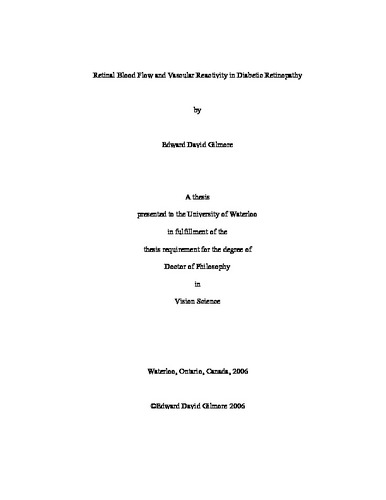| dc.description.abstract | Introduction
Retinal vascular reactivity is impaired in patients with diabetes and is thought to be involved in the onset and progression of diabetic retinopathy (DR). Previous studies that have utilized hyperoxia to assess retinal vascular reactivity have been limited due to confounding factors associated with the administration of oxygen and have used a variety of different instruments to measure retinal blood flow. The influence of blood glucose at the time of blood flow assessment has also not been systemically investigated.
The specific aims of each Chapter are as follows:
Chapter 3: To compare three systems used to administer hyperoxia to human subjects.
Chapter 4: To quantify the magnitude and timeline of change of retinal hemodynamic parameters induced by an isocapnic hyperoxic stimulus.
Chapters 5, 6 and 7: To quantify the magnitude of change of retinal hemodynamic parameters induced by hyperoxia, hyperglycemia and combined hyperoxia / hyperglycemia, respectively, in groups of diabetic patients with no clinically visible, and mild-to-moderate, DR and in age-matched subjects without diabetes.
Methods
Chapter 3: Subjects breathed air followed by oxygen, or oxygen plus carbon dioxide using a non-rebreathing system, or air followed by oxygen using a sequential rebreathing system. The magnitude of change and variability of CO2 concentrations was compared between systems.
Chapter 4: Baseline retinal blood flow data was acquired while the subjects breathed air using a sequential rebreathing system. An isocapnic hyperoxic stimulus was initiated and maintained for 20 minutes. Air was then re-administered for 10 minutes. Retinal blood flow measurements were acquired every minute over the course of the study. The magnitude of change of each hemodynamic parameter was determined by fitting individual data with a sigmoidal function.
For Chapter 5, 6 and 7 diabetic patients with no clinically visible, and mild-to-moderate, DR were stratified into groups based upon their retinopathy status. Age-matched non-diabetic subjects were recruited as controls. Baseline retinal blood flow data was acquired while subjects breathed air. Retinal blood flow measurements were then acquired after exposure to (a) hyperoxia, (b) hyperglycemia and (c) combined hyperoxic / hyperglycemic stimuli. Change in hemodynamic parameters was compared between groups and correlated with objective measures of retinal edema.
Results
Chapter 3: The difference in group mean end-tidal CO2 levels between baseline and hyperoxia was significant for oxygen administration using a non-rebreathing system. The sequential rebreathing technique resulted in a significantly lower variability of individual CO2 levels than either of the other techniques.
Chapter 4: An ~11% decrease of diameter, ~36% decrease of velocity and ~48% decrease of blood flow was observed in response to isocapnic hyperoxia in young, healthy subjects. A response time of 2.30±0.53 minutes and 2.62±0.54 minutes was observed for diameter and velocity, respectively.
Chapter 5: Retinal blood velocity, flow, and WSR significantly decreased in response to isocapnic hyperoxia in all groups. The magnitude of the reduction of blood flow was significantly reduced with increasing severity of retinopathy. There was a significant relationship between baseline objective edema index values and retinal vascular reactivity.
Chapter 6: A significant change in blood glucose level was observed for all groups. No significant change in any hemodynamic parameter was found in patients with diabetes and in age-matched subjects without diabetes.
Chapter 7: Retinal blood velocity and flow significantly decreased in all groups in response to combined hyperoxic / hyperglycemic provocation. The vascular reactivity response was not significantly different across the groups.
Conclusions
Chapter 3: Control of CO2 is necessary to attain standardized, reproducible hyperoxic stimuli for the assessment of retinal vascular reactivity.
Chapter 4: Arteriolar retinal vascular reactivity to isocapnic hyperoxic provocation occurs within a maximum of 4 minutes. Although there was a trend for diameter to respond before velocity, the response characteristics were not significantly different between diameter and velocity. Different response characteristics of the retinal vasculature to transmural pressure mediated autoregulation as opposed to metabolic mediated vascular reactivity are suggested.
Chapter 5: The vascular reactivity response in terms of the reduction of blood flow relative to baseline was significant in all groups but the magnitude of the change in flow was significantly reduced with increasing severity of retinopathy. A loss of retinal vascular reactivity is indicated in patients with moderate DR without clinically evident diabetic macular edema (DME), and in patients with DME.
Chapter 6: Unaltered retinal arteriolar blood flow was found 1 hour after glucose ingestion in patients with diabetes and in age-matched subjects without diabetes. These results do not support the theory that retinal blood flow is affected by an acute increase of blood glucose in diabetic patients and in subjects without diabetes.
Chapter 7: The vascular reactivity response to a combined hyperoxic / hyperglycemic provocation produced a pronounced reduction in blood flow. Unlike the response to hyperoxia alone, the vascular reactivity response was not significantly different across the groups. This suggests that hyperglycemia may influence the retinal vascular reactivity response to hyperoxia. | en |

